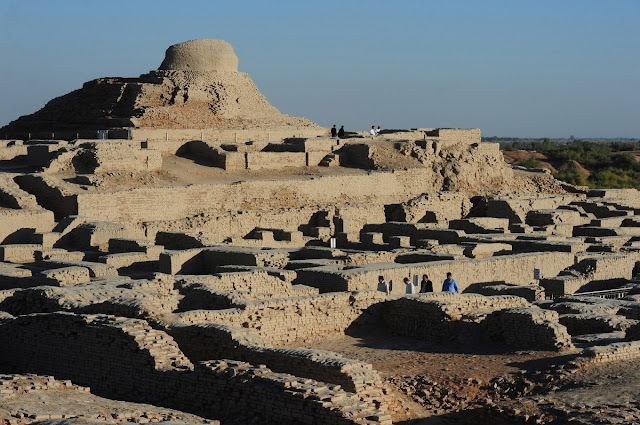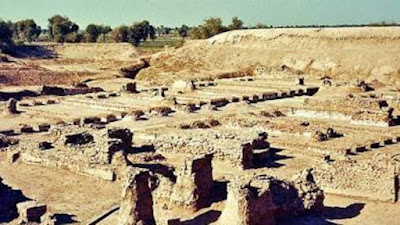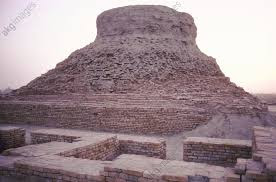Mohenjo Daro Sindh, Pakistan
The history of the Sindh province of Pakistan is very old and Mohenjo-Daro, located 35 km from Larkana, which has traces of ancient settlements of more than 3,000 years, is proof of this.
Mohenjo Daro Meaning, Disappearance, and History
Manjo Daro is a Sindhi word, which means "the mound or cliff of dead people". Manjo Daro was a center of ancient civilization in the Mehran Indus Valley.
According to archaeologists, the city existed in 2600 BC and disappeared in 1700 BC for unknown reasons.

Floods, diversion of the Indus, earthquakes, or external aggression may be the reasons for its demise. According to experts, the city was razed seven times and rebuilt. It is also mentioned in the oldest Hindu book, the Rig Veda.
In the light of the present research, the information provided shows that the Indus Valley was the cradle of a great civilization in 2300 BC.
Mohenjo-Daro A Tourist Destination
Mohenjo Daro, Harappa
The strongest government in this valley was established by which the foundations were stabilized for centuries. There were two capitals of this government, a 'Harappa' and the second 'Mohanjo Darou
Harappa Location
Harappa is located in the "Sahiwal" east edge of the river Ravi.
Mohenjo-Daro Location
And the signs of "Mohenjo Daro's greatness" in the district Larkana, six miles away from the Dokri railway station, at the banks of river Sindh can be seen.

Mohenjo-Daro, How it named
Mohenjo-Daro, the mound or cliff of dead people," was the right name of this town, but people who dig this ancient site were unaware of the ancient language that is why everyone calls it Manjodaro.
Steps were taken by Sindh Government
The locals said that the Sindh government had also issued circulars to all departments in this regard. But the name of Mohenjo-Daro remained in the language of the people because there is a paved road, and the river Indus flows to its east.
Mohenjo Daro and Today's World
Standing on a high place if the whole settlement is examined, then the settlement of Mahenjo Daro appears to consist of six or seven neighborhoods. The neighborhood is spread over an area of "North, South 1200" and "East, West 800" feet.
These neighborhoods are separated by wide highways. The city is similar in shape to the ancient cities of Britain, just as the Irish Ocean separates Ireland from England, just as an ancient Indus flood may have separated the Stupa area from another region.
And now these ruins are divided into two major parts. One upper city and the other lower city. The upper city is located on an elliptical hill at the western end of the ancient settlement.
Notables
Particularly notable in this city are the stupa, a large hall, the pool, the seminary, and the large pillar hall. The low-lying city has residential houses, shops, open roads, and streets. These ruins also reflect the current style of construction.
Words by Englishman
Looking at these ruins, an Englishman said that standing in these ruins feels like standing in the ruins of Lancashire. He added that the connection between Mohenjo-Daro's First Highway and East Highway seems to be the intersection of Oxford Circus.
Speculations about Mohenjo-Daro
All that is known in the accounts of locals and domestic tourists is that before the arrival of the Aryans, the subcontinent was inhabited by savage and uncivilized people. But after the excavation of Mohenjo-Daro, this statement became completely false.
Real Facts
However, it is certain that at the time of the arrival of the Aryans, the people of the subcontinent were lost in luxury because of the buildings.
And as the spirit of amassing wealth intensified, the essence of bravery and sacrifice had waned among them, which is why they were defeated by the Aryans.

People of ancient Indus Valley and Their Way of Living
Otherwise, 3000 years ago, there were intelligent and conscious people in the Indus Valley who were no less than any other civilized human race of the present age.
Well Civilized
These people were well acquainted with the principles of living, they had artistic talents. They were an expert in architecture, the beauty, and sophistication of their creations was at its peak.
They were an expert in agriculture and trade. The houses they built were the best example of beauty and strength. they were familiar with the principles of hygiene.
Well Developed
The principles of measurement were rigorously tested. Ventilated buildings, wide roads, drainage systems show that they were highly developed.
Diamond jewelry and gold, silver jewelry, and utensils indicate their art. They were used to do everything according to plan. They dug canals for irrigation, built dams to avoid floods. They used bronze and copper utensils and tools as well as stone utensils and tools.
Script
They had a script in which they wrote. It is a pity that this script has not been read and understood to this day despite great efforts. These people were experts in stone carving and made beautiful and exquisite paintings on stones.
Harappa & Mohenjo-Daro Civilizations
There is a distance of 400 miles between Mohenjo-Daro and Harappa, but the structure and architecture of the two areas are the same.
Architecture
Thus these two places are two centers of the same civilization more than three thousand years old, and both were capitals of the same ruler. Mohenjo-Daro buildings are simple and mature.
All the residential houses are comfortable and nice, the foundations are deep enough, special care has been taken to protect the buildings from floods.
construction in Mohenjo Daro and Harappa was done using bricks. The bricks used in the walls are of both small and large sizes, nets have been installed in the walls for air, in addition to residential buildings, large buildings, bathrooms, and baths have also been constructed.
Mohenjo-Daro roads are wind-blown, the largest being more than 35 feet wide. One road is 18 feet wide and the other 13 feet wide. The streets are more than 9 feet wide.
Mohenjo-Daro's thousands of years old wells provide clean and fresh water after removing debris and mud.
There must have been a well in every big house. The wells were built in a part of the houses so that not only the people in the house but also the outsiders could benefit from them.
The method of drainage of wastewater found in Mohenjo-Daro was unheard of in any civilization on earth at that time.
Drainage drains were constructed on both sides of the streets and sidewalks, which were covered with stone slabs these were picked up during cleaning.
There are also some buildings in Mohenjo-Daro that are believed to have baths. They have taps that are used to deliver hot water to the baths.
Society & Socialism
The people of this city also gambled and the practice of playing dice was common, the dice were square in shape. These pennies are exactly like that like our astrologers have brass pans. They also fought birds and quail.
The women of this period were fond of make-up, used sarma and Gaza, wore gold, silver, and diamond jewelry.
Women also wore white powder on their faces, jewelry, such as necklaces and rings, was also used.
Women used to decorate their hair well but men used to decorate their hair more than women. They were well versed in dance and music.
Things Recovered by Excavations
Sanda, buffalo, sheep, elephant, and chicken skeletons have also been recovered during the excavations.
Paintings on children's toys also show that they were familiar with dogs, cats, monkeys, peacocks, and parrots. Excavations in the city have also uncovered chess pieces that bear a striking resemblance to modern-day chess.
A large number of children's toys with various pictures have also been recovered from Mohenjo-Daro.
